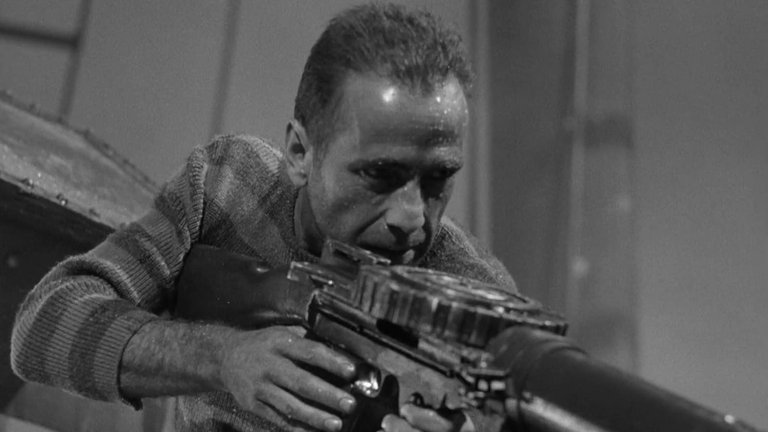Film Review: Passage to Marseille (1944)

Casablanca is arguably the most iconic of all the films of Classic Hollywood era and one of the best known films in entire history of cinema. Because of that, any idea of shooting a sequel or having it remade was greeted as sacrilege not only by cinephiles, but also by general public. Hollywood studios, that would have little hesitation in doing so with almost all other films, were forced to make very indirect remakes like Barb Wire or merely pay homage with a reference or two in unrelated films. However, only two years after Casablanca came Passage to Marseille, a film that could be described as its spiritual sequel thanks to having the similar setting, theme, cast and director Michael Curtiz.
The film is based on Men Without Country, 1942 novel by Charles Nordhoff and James Norman Hall. The plot begins in England during Second World War where journalist Manning (played by John Loder) visits the base of Free French air squadron operating B-17 Flying Fortress bombers that fly missions over Nazi Germany. Captain Fraycinet (played by Claude Rains), one of its commanders, begins to tell the tale how he has met some of his men. The story, told in flashback, switches to the first year of the war when Fraycinet got transferred from New Caledonia to Marseille and had to spends long time travelling on a tramp steamer Ville de Nancy. In late Spring 1940 the ship rescues five men from small canoe that was drifting in Caribbean Sea. Fraycinet suspects that the men are convicts that have escaped from the infamous penal colony in French Guayana. Men admit that they are indeed convicts and they describe that their escape was motivated less with the desire for freedom and more with patriotism and conviction that they can redeem themselves if they fight for their country against Germans. Their leader is Jean Matrac (played by Humphrey Bogart), newspaper editor who was wrongfully sentenced for manslaughter after making enemies in pre-war France with his passionate critique of Munich Agreement.
Passage to Marseille was made while the war still raging on and, like all Hollywood films made after US entry into the conflict, it served propaganda purposes. While Casablanca had celebrated anti-fascist resistance in general, using the North African city under Vichy French control as exotic setting, this film was more focused on France and its citizens that had refused to reconcile with humiliating defeat and enemy occupation, which was still going on during the film’s production. Inevitable comparisons between two films show that the propaganda in latter film is much cruder, with characters lacking complexities and being simply divided into villains (like treacherous pro-German officer played by Sidney Greenstreet) and heroes (more or less, anybody else). This lack of complexity reflects on the protagonist who is played by somewhat disinterested Humphrey Bogart (whose marriage to his third wife Mayo Methot was falling apart at the time). It is Claude Rains that actually serves as proper protagonist and whose character keeps film together. His role is even more important due to narrative technique of “flashback within flashback” which was relatively rare at the time and that some critics and part of the audience found confusing. The rest of the cast is more than solid and implicitly underlines major motive of propaganda war against Nazism as international effort by having actors from different countries – Dutch actor Philip Dorn as one of the convicts, Russian actor Vladimir Sokoloff as elderly convict and Belgian actor Victor Francen as ship’s captain. French film star Michèle Morgan, beautiful actress that was supposed to be Bogart’s partner in Casablanca instead of Ingrid Bergman, is here reduced to playing generic role of love interest, wife and mother.
From a technical standpoint, Passage to Marseille is well-made film. Black-and-white cinematography by veteran James Wong Howe is superb and accompanied by effective music soundtrack by Max Steiner. Curtiz, who had made great job with Casablanca, is adequate here and he easily brings many scenes taking place on different countries and continents, while actually being all shot in California. The most impressive is spectacular action scene near the end when Ville de Nancy has to endure attack by Focke Wulf 200, German naval bomber. Yet, all this skill can’t overcome deficiencies in the script that makes Passage to Marseille too preachy and overlong. Scene in which protagonist murders downed German airmen instead of taking them prisoner is not going to sit well with some of the modern sentiments and few people would accept Bogart playing someone who could easily be described as war criminal. This scene was disturbing even during the war itself and was actually cut by censors in many countries. Passage to Marseille had more than solid box office results but it is now considered one of the more obscure parts of Bogart’s filmography. Although they might enjoy solid film, many of today’s viewers would likely become aware why it happened.
RATING: 6/10 (++)
Blog in Croatian https://draxblog.com
Blog in English https://draxreview.wordpress.com/
Leofinance blog https://leofinance.io/@drax.leo
Unstoppable Domains: https://unstoppabledomains.com/?ref=3fc23fc42c1b417
Hiveonboard: https://hiveonboard.com?ref=drax y
Bitcoin Lightning HIVE donations: https://v4v.app/v1/lnurlp/qrcode/drax
Rising Star game: https://www.risingstargame.com?referrer=drax
1Inch: https://1inch.exchange/#/r/0x83823d8CCB74F828148258BB4457642124b1328e
BTC donations: 1EWxiMiP6iiG9rger3NuUSd6HByaxQWafG
ETH donations: 0xB305F144323b99e6f8b1d66f5D7DE78B498C32A7

!LOLZ
lolztoken.com
But he hesitated.
Credit: reddit
@drax, I sent you an $LOLZ on behalf of ggggggggg
(5/6)
NEW: Join LOLZ's Daily Earn and Burn Contest and win $LOLZ
Yay! 🤗
Your content has been boosted with Ecency Points, by @drax.
Use Ecency daily to boost your growth on platform!
Support Ecency
Vote for new Proposal
Delegate HP and earn more
Reviewed and Approved for an Ecency boost. Keep up the good work.